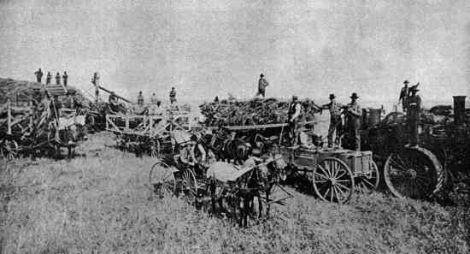More from the 1884 to 1888 dairies of Mary Dodge Woodward, who lived on the 1,500-acre Dodge bonanza farm near Fargo, Dakota Territory, during those years. Mary’s son Walter managed the farm for a cousin, Daniel Dodge.
“Aug. 12, 1884: Walter went to Fargo for (binder) twine … went with a double wagon. (Author’s note: Binder twine was a huge expense for bonanza farms.)
“Aug. 27, 1884: Our boys finished harvesting all the wheat and oats. McKay, who is to thresh, with his crew of 20 men, his tents and his cookhouse are already on the grounds. The outfit looks very picturesque among the shocks of wheat. The country teems with threshing machines. I could see eight this morning, each with a crew of from 20 to 30 men, which makes for lively times.
“Aug. 11, 1885: Harvest has started. Now there will be no rest for man, woman or beast until frost, which comes, thank heaven, early here. I was nearly beside myself getting dinner for 13 men, with Katie sick in bed. I baked 17 loaves of bread today, making 74 loaves since last Sunday, not to mention 21 pies, and puddings, cakes and doughnuts.
“The men cut 100 acres today. All four of our harvesters are being used as well as three hired to cut by the acre. The twine to bind our grain will cost $300 this year.
“How beautiful the wheat fields look, long avenues between the shocks, just as straight, one mile in length!
“Aug. 6, 1886: A beautiful day. The men are all harvesting. They have been cutting 60 acres a day with all five harvesters running. The reapers are flying all about us, stretching out their long white arms and grasping in the grain. The shocks, which begin to dot the prairie, look very beautiful as one passes miles of them standing in neat, straight rows.
“Sept. 7, 1886: The men finished threshing. We have 13,540 bushels of wheat and 4,004 bushels of oats. If we could get $1 a bushel for it, there would be quite a profit in this year’s work. (Author’s note: Mary constantly complained about the price of wheat, which was usually much less than a dollar.)
“Aug. 1, 1887: We now have 20 men, all the dining room will hold. We have put a second table at the end of the extension table. We have a good girl this time. She is kind and suits me, even if she cannot do the fancy cooking. (Author’s note: Mary often had trouble with her kitchen help)
“Daniel and Walter went to Fargo, where they bought a thresher (and engine). Daniel says he cannot afford to hire a thresher (when) wheat brings so little.
“Aug. 13, 1887: They have been running the new machine to try it, an Ames engine and an Advance separator. It looks very queer to see an engine running around the yard with no horses attached to it.
“Aug. 19, 1888: Sunday. All men harvesting. There is too great a risk to wheat to let it go on the Sabbath day – risk from hail, wind and rain storms.
“Aug. 30, 1888: A regular procession started for the quarter-section after dinner: engine ahead; teams all behind, 11 of them. I can see a dozen threshing machines from here and the smoke of as many more.
“Sept. 8, 1888: The men threshed 1,300 bushels, but had to stop for the wind blew so hard that they could not keep the belt on the machine. It blew the bundles, too, so that they could not manage them.”
Mary’s diary is a fascinating glimpse of life in Dakota Territory during the 1880s. She especially disliked the winters, which were terrible.FC






